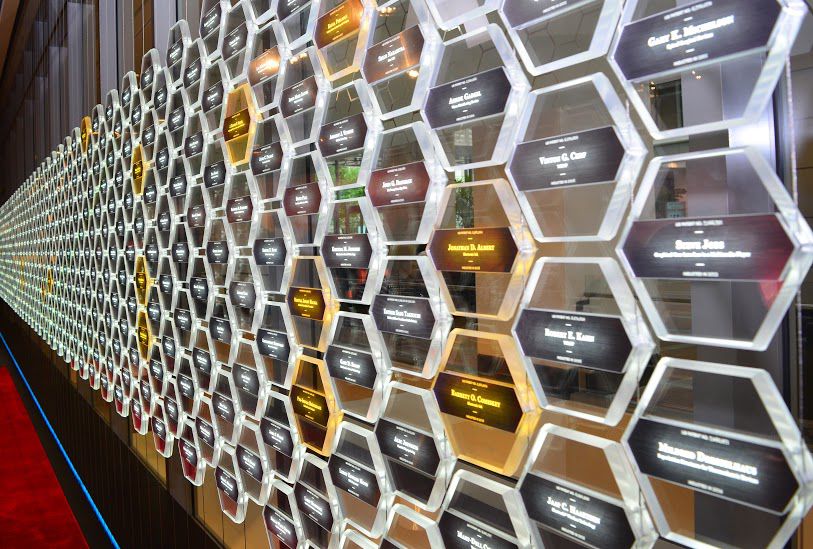Americans often take for granted the mechanics of a car, cell phone, electronic tablet and even the internet—all great inventionsdeserving of protective patents. Even more personal, patents for ideas such as water purification, food safety, the Epi-Pen, and dental implants also need recognition.
All of these life-changing inventions, along with those for carbon fiber and butyl rubber, were recognized at the annual ceremony at the National Inventors Hall of Fame in Alexandria.
The United States Patent and Trademark Office (USPTO) opened its doors to the 44th Annual National Inventors Hall of Fame Induction Ceremony, honoring 16 inventors who have had a revolutionary impact on American progress. Hall of Fame inductees placed their emblem on the prismatic glass wall of inventor’s names—a group of interlocking hexagons modeled after the honeycomb, nature’s proof of a successful bee hive. All abuzz with excitement, nearly 100 attendees witnessed the induction of these innovation trailblazers into the Hall of Fame and the unveiling of the expanded National Inventors Hall of Fame Museum. Together, these great minds have influenced continued progression in the past, present and future.
Mo Rocca, Emmy award-winning CBS Sunday Morning correspondent and Host of The Henry Ford’s Innovation Nation, served as Master of Ceremonies, and cut the ribbon to the new Intellectual Property Power™ Exhibit. The new wing of the museum included a walk through the progression and development of the camera, from its early days in 1887 to a wafer-thin chip in all smartphones. Just inside the doors, visitors met a “50-year old with a split personality,” a Ford Mustang from 1965 merged together with a Mustang from 2015, to showcase the car’s progress. Elsewhere in the new wing, the Qualcomm interactive display showcased smartphone technology that enhanced the lives of billions of people worldwide, a process which began decades ago with the aim of giving people their own phone number.
“It is a privilege to partner with the National Inventors Hall of Fame for more than four decades and highlight the nation’s brightest luminaries while inspiring the next generation of innovators,” said Under Secretary of Commerce for Intellectual Property and Director of the United States Patent and Trademark Office Michelle K. Lee. “This year, the USPTO is thrilled to also help unveil a reinvigorated museum that celebrates the story of Intellectual Property and illuminates its significance to American life, progress, innovation and culture.”
The Inventors Hall of Fame also showcased many other notable inventions such as skin grafting, the Gossamer Condor (self-propelled aircraft), a graphing calculator, portable batteries, dry cleaning, and Bluetooth wireless connectivity. Also with the help of Hall of Fame inductees, the museum has nurtured and highlighted curiosity in two million children with its Camp Invention.
“Our role as a Hall of Fame is to honor individuals whose inventions have made significant contributions to modern life. But our purpose is to assure that American ingenuity continues to thrive in the hands of coming generations,” said CEO Michael Oister. “The National Inventors Hall of Fame is the only Hall of Fame that pays it forward and continues to be an advocate of innovation through our K-12 educational programs, and it starts with the Greatest Celebration of American Innovation.”


